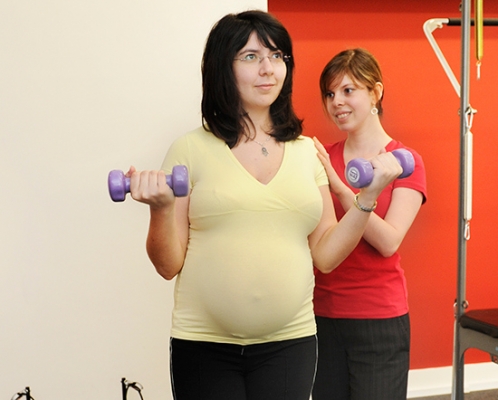Exercising during pregnancy can be a difficult task. Many factors need to be taken into account including your fitness levels before pregnancy and the type of exercise you are doing.
High impact exercise or lifting heavy weights can be risky especially once in the second trimester and there are specific positions that need to be avoided.
Taking all of this into account plus the fact that pregnancies do differ in each individual it is important to consult your doctor or obstetrician before commencing any exercise program whilst pregnant.
Once given the ok to exercise it is important to choose something that you feel comfortable and safe doing. For many women Clinical Pilates is a great option. Some benefits of prenatal and antenatal Clinical Pilates include:
- Safer than many exercise alternatives
- Supervised sessions with specialist physiotherapists as your instructors
- Improves your core strength, posture and pelvic floor strength
- Helps prevent and manage incontinence during and after pregnancy
- Maintain your strength and fitness
- Help manage and prevent back pain, neck pain and joint pain
- Improve posture, flexibility and balance
- Helps prepare the body for labour
- Easier labour
- Aids in a quicker recovery post labour and improved body shape
- Sociable – a great way to meet like-minded people
As research has progressed more and more health professionals are recommending Clinical Pilates before, during and after pregnancy to help with issues faced by pregnant women during and after pregnancy. These issues can be related to lower back pain, pelvic pain and incontinence to name a few. Other exercise types which are generally safe and effective during pregnancy are walking and swimming.
During pregnancy ligaments become more elastic due to the release of the hormone relaxin and as a result once well supported joints such as the spine and pelvis can become painful. This is because the ligaments are no longer supporting the joint as tightly as they were before and the added weight of the baby can cause the joints to move differently and cause irritation in surrounding areas. These are some common reasons for the abovementioned problems which many pregnant women face.
Besides exercise it is also important to consider nutrition as both are paramount in helping you to stay healthy and fit during pregnancy. They will also be two vital factors which will help you to return to your pre-pregnancy body faster after you give birth. Here are some guidelines which can help you get started:
1. Eating 2-3 servings of raw fruit and 5 servings of raw vegetables daily.
It’s extremely important to eat fruit and vegies raw as they lose their nutrients in the cooking process, plus we usually add cooking oils/sauces which does not help with weight loss and maintaining health.
2. Drinking 1.5-2L of water daily.
During pregnancy it is extremely important to drink more than you would normally in order to avoid dehydration. Once you have given birth drinking more water will also help with detox. Also worth noting is the fact that it is often easy to disguise thirst as hunger, and then eating something when what your body really needs is water.
3. Eating higher calorie foods for breakfast or lunch and keeping dinner very light. Also trying not to eat after 6pm.
By having heavier foods earlier on in the day your body will have more time to burn the calories as opposed to eating late.
4. Eat good fibre and healthy fats.
If you are a lover of carbs and find it hard to go without them you can still have bread, pasta and rice occasionally, just make sure that it’s not the refined white flour. Healthier options include yeast free pasta and bread.

